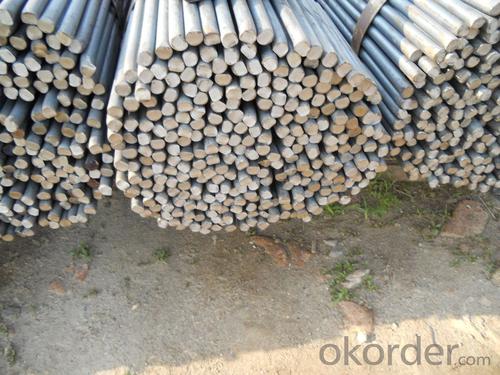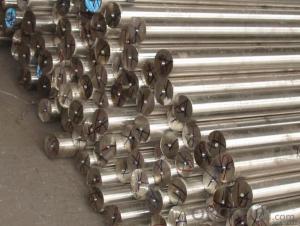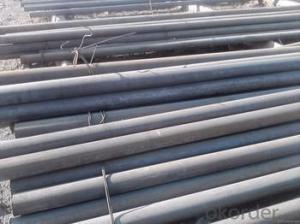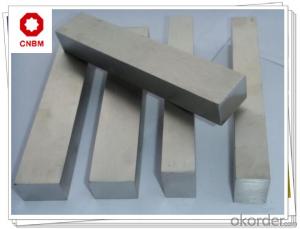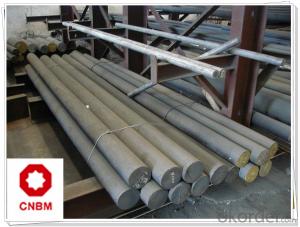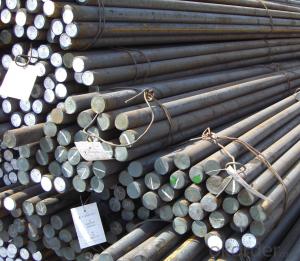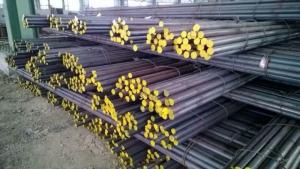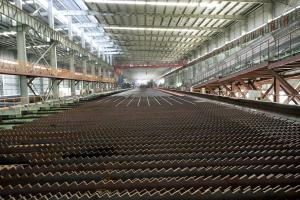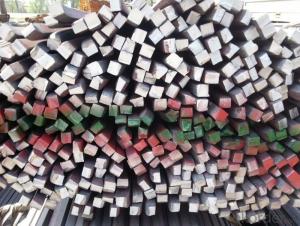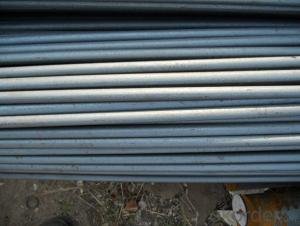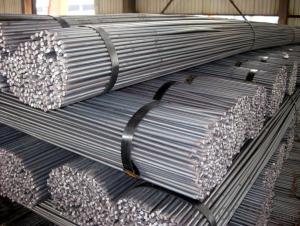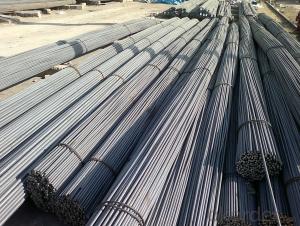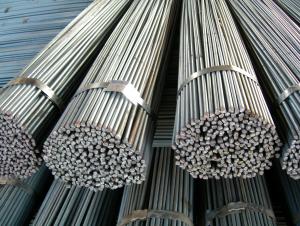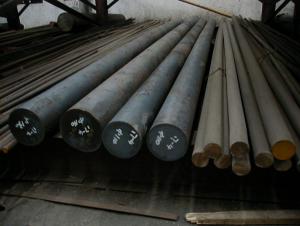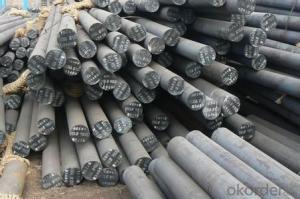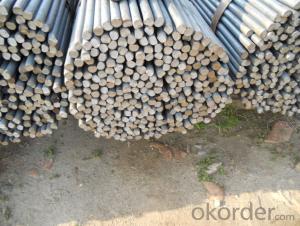Low Carbon Hot Rolled Steel Round Bar in Bundle
- Loading Port:
- China main port
- Payment Terms:
- TT OR LC
- Min Order Qty:
- 100 m.t.
- Supply Capability:
- 5000 m.t./month
OKorder Service Pledge
OKorder Financial Service
You Might Also Like
Product Description:
OKorder is offering Low Carbon Hot Rolled Steel Round Bar in Bundle at great prices with worldwide shipping. Our supplier is a world-class manufacturer of steel, with our products utilized the world over. OKorder annually supplies products to African, South American and Asian markets. We provide quotations within 24 hours of receiving an inquiry and guarantee competitive prices.
Product Applications:
Low Carbon Hot Rolled Steel Round Bar in Bundle are ideal for structural applications and are widely used in the construction of buildings and bridges, and the manufacturing, petrochemical, and transportation industries.
Product Advantages:
OKorder's Low Carbon Hot Rolled Steel Round Bar in Bundle are durable, strong, and wide variety of sizes.
Main Product Features:
· Premium quality
· Prompt delivery & seaworthy packing (30 days after receiving deposit)
· Can be recycled and reused
· Mill test certification
· Professional Service
· Competitive pricing
Product Specifications:
Manufacture: Hot rolled
Grade: Q195 – 235
Certificates: ISO, SGS, BV, CIQ
Length: 6m – 12m, as per customer request
Packaging: Export packing, nude packing, bundled
| ROUND BAR | |
| SIZE d(mm) | theoretical kg/m |
| 5.5 | 0.186 |
| 6 | 0.222 |
| 7 | 0.302 |
| 8 | 0.395 |
| 9 | 0.499 |
| 10 | 0.617 |
| 11 | 0.746 |
| 12 | 0.888 |
| 13 | 1.04 |
| 14 | 1.21 |
| 15 | 1.39 |
| 16 | 1.58 |
| 17 | 1.78 |
| 18 | 2 |
| 19 | 2.23 |
| 20 | 2.47 |
| 21 | 2.72 |
| 22 | 2.98 |
| 24 | 3.55 |
| 25 | 3.85 |
| 26 | 4.17 |
| 28 | 4.83 |
| 30 | 5.55 |
| 32 | 6.31 |
| 34 | 7.13 |
| 36 | 7.99 |
| 38 | 8.9 |
| 40 | 9.86 |
| 42 | 10.9 |
| 45 | 12.5 |
| 48 | 14.2 |
| 50 | 15.4 |
| 53 | 17.3 |
| 56 | 19.3 |
| 60 | 22.2 |
| 63 | 24.5 |
| 65 | 26 |
| 70 | 30.2 |
| 75 | 34.7 |
| 80 | 39.5 |
| 85 | 44.5 |
| 90 | 49.9 |
| 95 | 55.6 |
| 100 | 61.7 |
FAQ:
Q1: Why buy Materials & Equipment from OKorder.com?
A1: All products offered byOKorder.com are carefully selected from China's most reliable manufacturing enterprises. Through its ISO certifications, OKorder.com adheres to the highest standards and a commitment to supply chain safety and customer satisfaction.
Q2: How do we guarantee the quality of our products?
A2: We have established an advanced quality management system which conducts strict quality tests at every step, from raw materials to the final product. At the same time, we provide extensive follow-up service assurances as required.
Q3: How many tons of steel products could be loaded in containers?
A3: Usually the steel products are delivered by bulk vessel because of the large quantity and the freight. However, there are no bulk vessel enter some seaports so that we have to deliver the cargo by containers. The 6m steel product can be loaded in 20FT container, but the quantity is changed according to the size, usually from 18tons to 25tons.
Images:
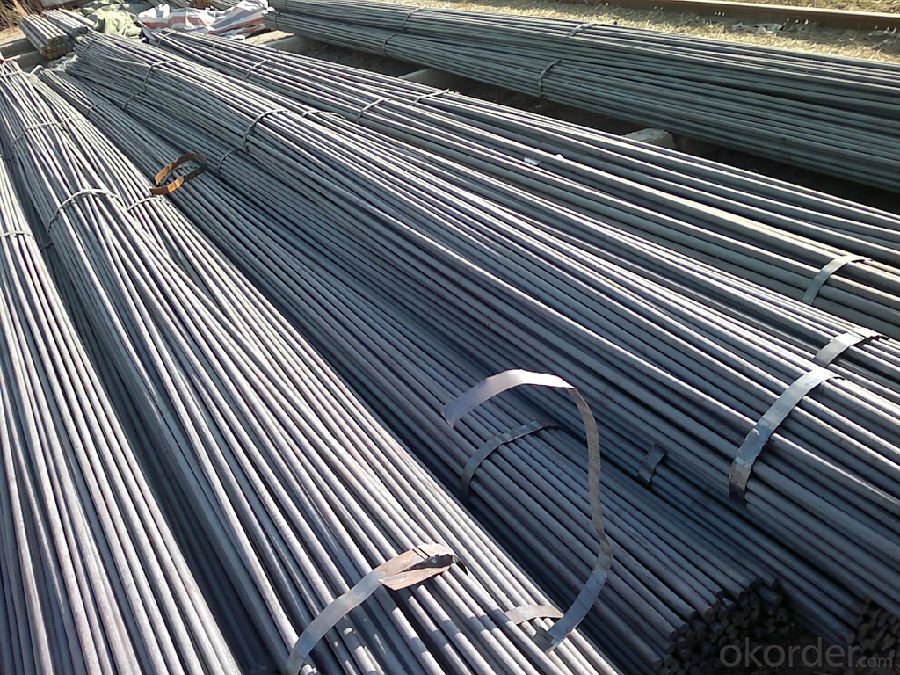
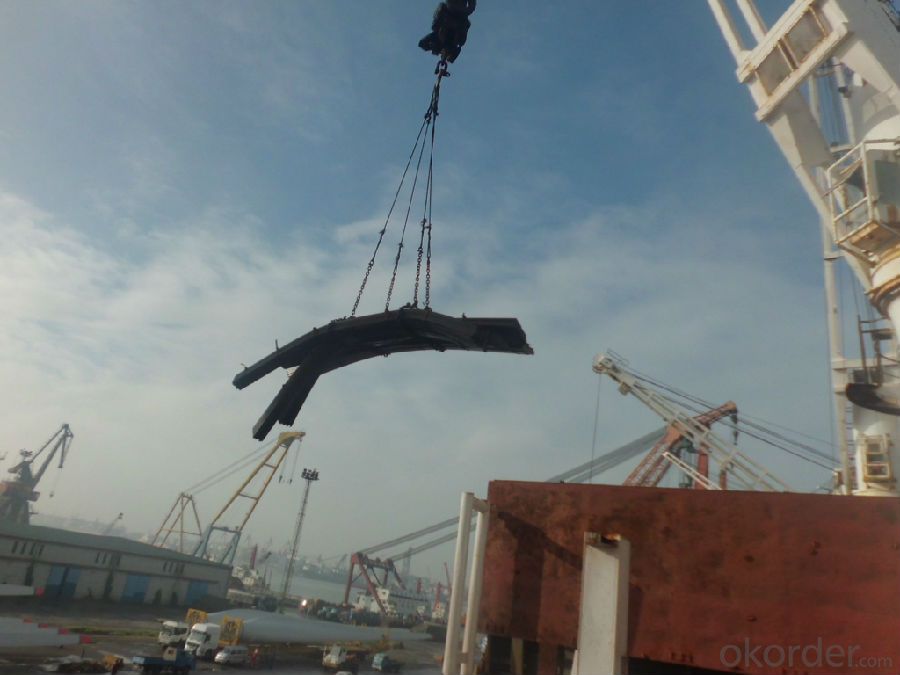
- Q: Can steel round bars be cold worked?
- Yes, steel round bars can be cold worked. Cold working refers to the process of plastic deformation of a metal below its recrystallization temperature. This technique is commonly used to increase the strength and hardness of steel round bars. Cold working can be achieved through various methods such as cold rolling, cold drawing, or cold forging. These processes apply compressive forces to the steel, causing its shape to change without the need for heating. Cold working can result in improved mechanical properties, increased dimensional accuracy, and a smoother surface finish for steel round bars.
- Q: How do you prevent warping of steel round bars during machining?
- There are several measures that can be taken to prevent warping of steel round bars during machining. These measures include: 1. Opting for the appropriate steel material with suitable mechanical properties is crucial. Choosing steel with lower carbon content and controlled alloying elements can help decrease the likelihood of warping during machining. 2. Before machining, it is important to conduct a stress relief process such as annealing or normalizing. This helps eliminate internal stresses in the steel round bars, thereby minimizing warping. 3. Utilizing proper machining techniques is essential in preventing warping. This involves using a stable and rigid machine setup, ensuring correct tool geometry and sharpness, and maintaining appropriate cutting speeds and feeds. Monitoring cutting forces and temperatures continuously can also assist in identifying any abnormal conditions that may contribute to warping. 4. Excessive heat generated during machining can cause localized expansion and lead to warping. To prevent this, it is recommended to use coolant or lubricant to dissipate heat and reduce friction between the tool and the workpiece. Sufficient cooling helps maintain a stable temperature and prevents warping. 5. When machining long steel round bars, it is advisable to use appropriate fixtures or supports to prevent excessive deflection or bending. This ensures that the bar remains straight and stable during machining, reducing the chances of warping. 6. Even after machining, stress can still be present in the steel round bars. Performing a post-machining stress relief process, such as tempering or normalization, can further alleviate any residual stresses and minimize the risk of warping. By implementing these measures, the risk of warping during the machining of steel round bars can be significantly reduced. This leads to improved dimensional accuracy and overall quality of the machined parts.
- Q: What is the difference between a bright and a black steel round bar?
- The appearance and surface finish are the main factors that differentiate a bright steel round bar from a black steel round bar. A bright steel round bar, also referred to as a bright drawn or turned bar, possesses a sleek and glossy surface. This is accomplished through a process known as cold drawing, wherein the steel bar is pulled through a die to eliminate any flaws and create a consistent shape. The outcome is a highly polished and reflective surface that is aesthetically pleasing. Conversely, a black steel round bar features a dark, rough, and non-reflective surface. This is due to the fact that it does not undergo the same cold drawing process as a bright steel bar. The black surface is typically a result of the scale that forms on the steel during the manufacturing process, which remains intact. In terms of properties, both bright and black steel round bars are composed of the same material, typically carbon steel. Thus, their mechanical properties such as strength, hardness, and toughness are generally similar. However, the manufacturing process of the bright steel bar aids in enhancing its surface quality and dimensional accuracy in comparison to the black steel bar. Ultimately, the choice between a bright and a black steel round bar depends on the desired aesthetic appearance and the specific requirements of the application. Bright steel bars are commonly used in decorative applications where a polished and visually appealing finish is desired. On the other hand, black steel bars are often utilized in structural applications where surface appearance is less important but strength and durability are crucial.
- Q: Why can't the grounding device be replaced by steel bar instead of round steel?
- The mechanical strength of the steel thread is destroyed. Because the supporting point is only the ground, it is easy to cut the steel directly if the thread is not vertical. Therefore, we need to use angle iron, steel pipe or smooth steel round bar.
- Q: What is the maximum temperature steel round bars can withstand?
- The maximum temperature that steel round bars can withstand depends on the specific grade and composition of the steel. However, most standard carbon steels can typically withstand temperatures up to approximately 1000°C (1832°F) before their mechanical properties begin to significantly degrade.
- Q: How do steel round bars compare to aluminum or steel tubing?
- Steel round bars, aluminum tubing, and steel tubing all have their own unique properties and applications, so it is important to understand the characteristics of each material before making a comparison. Steel round bars are solid cylindrical bars made of steel. They are known for their high strength and durability, making them suitable for heavy-duty applications. Steel round bars have excellent tensile strength and can withstand high levels of stress and pressure. They are often used in construction, manufacturing, and engineering projects where strength and structural integrity are crucial. Steel round bars are also highly resistant to corrosion, making them suitable for outdoor and marine applications. Aluminum tubing, on the other hand, is made from aluminum, which is a lightweight and corrosion-resistant material. Aluminum tubing is known for its excellent thermal conductivity and electrical conductivity. It is often used in applications where weight reduction is important, such as in the aerospace and automotive industries. Aluminum tubing is also commonly used in the construction of heat exchangers and in electrical wiring systems due to its conductivity properties. Steel tubing, similar to steel round bars, is made of steel but is hollow in shape. Steel tubing is known for its versatility and wide range of applications. It is available in various shapes and sizes, including round, square, and rectangular, allowing for different structural designs. Steel tubing is often used in construction, automotive manufacturing, and industrial applications. It offers high strength and rigidity, making it suitable for applications that require structural support or the ability to withstand heavy loads. In comparison, steel round bars offer superior strength and durability compared to aluminum and steel tubing. They are ideal for heavy-duty applications that require high levels of strength and structural integrity. However, steel round bars can be heavier and more expensive than aluminum tubing, which is often preferred for lightweight applications. Steel tubing, on the other hand, provides versatility in terms of shape and size, allowing for more design options. Ultimately, the choice between steel round bars, aluminum tubing, and steel tubing depends on the specific requirements of the application, including factors such as strength, weight, cost, and corrosion resistance. It is important to carefully evaluate these factors and consult with experts to determine the most suitable material for a particular project.
- Q: What is the machinability of a steel round bar?
- The machinability of a steel round bar refers to its ability to be easily shaped, cut, and modified using various machining processes. It is a measure of how easily the steel material can be worked on with tools such as lathes, mills, drills, and other cutting or shaping tools. The machinability of a steel round bar is influenced by several factors, including the chemical composition of the steel, its microstructure, and any heat treatment processes it has undergone. Certain elements in the steel, such as sulfur, phosphorus, and lead, can improve or hinder machinability. Additionally, the presence of alloying elements, such as chromium, molybdenum, and nickel, can also impact the machinability of the steel. High machinability steel round bars are typically characterized by their ability to be easily cut, drilled, and shaped with minimal tool wear and power consumption. They also produce smooth, precise finishes with minimal surface defects. On the other hand, low machinability steel round bars are more difficult to work with, often requiring more power, specialized tools, and slower cutting speeds. It is important to consider the machinability of a steel round bar when selecting materials for machining applications. Factors such as the desired cutting speed, tool life, surface finish, and overall efficiency of the machining process should be taken into account. Additionally, the specific machining operations, such as turning, milling, or drilling, will also influence the choice of steel round bar with suitable machinability. Overall, the machinability of a steel round bar plays a crucial role in determining its suitability for various machining processes. Understanding the machinability characteristics of different steel grades can help in selecting the most appropriate material for specific machining applications, ensuring efficient and effective machining operations.
- Q: What are the advantages of using nickel-chromium-titanium alloy steel round bars?
- There are several advantages of using nickel-chromium-titanium alloy steel round bars: 1. High Strength: Nickel-chromium-titanium alloy steel round bars are known for their exceptional strength and durability. They have a high tensile strength, making them suitable for applications requiring heavy-duty materials. 2. Corrosion Resistance: These alloy steel round bars have excellent corrosion resistance properties due to the presence of nickel and chromium. This makes them ideal for use in environments where exposure to moisture, chemicals, or harsh conditions is common. 3. Heat Resistance: Nickel-chromium-titanium alloy steel round bars can withstand high temperatures without losing their mechanical properties. They exhibit good heat resistance, making them suitable for applications in industries such as aerospace, power generation, and automotive. 4. Fatigue Resistance: The unique composition of nickel-chromium-titanium alloy steel round bars provides excellent fatigue resistance, allowing them to withstand repeated stress and load cycles without deformation or failure. This makes them suitable for applications in high-stress environments. 5. Machinability: Despite their high strength and toughness, nickel-chromium-titanium alloy steel round bars are relatively easy to machine. They can be easily cut, drilled, or shaped, allowing for efficient and precise manufacturing processes. 6. Versatility: These alloy steel round bars have a wide range of applications due to their versatile properties. They can be used in industries such as construction, automotive, aerospace, marine, and many more. Their high strength and corrosion resistance make them suitable for various structural and load-bearing applications. Overall, nickel-chromium-titanium alloy steel round bars offer a combination of high strength, corrosion resistance, heat resistance, fatigue resistance, machinability, and versatility, making them a preferred choice for many industrial applications.
- Q: What are the different types of steel round bar surface treatments?
- The different types of steel round bar surface treatments include hot-dip galvanizing, electroplating, powder coating, and painting.
- Q: What are the different grades of steel round bars?
- There are several different grades of steel round bars, each with its own unique properties and characteristics. Some of the most common grades include: 1. Mild Steel: Also known as low carbon steel, this grade is the most widely used due to its affordability and versatility. It has a relatively low carbon content and is easy to weld and form. 2. Carbon Steel: This grade contains a higher carbon content than mild steel, making it stronger and more durable. It is commonly used in applications that require high strength and hardness, such as construction and machinery. 3. Alloy Steel: Alloy steel round bars are made by combining different elements, such as chromium, nickel, or molybdenum, with carbon steel. This creates a material with enhanced properties, such as increased corrosion resistance, improved toughness, and higher tensile strength. 4. Stainless Steel: Stainless steel round bars are made primarily from iron and contain a minimum of 10.5% chromium. This grade of steel is known for its excellent corrosion resistance and is commonly used in applications where hygiene and cleanliness are crucial, such as in the food and pharmaceutical industries. 5. Tool Steel: Tool steel round bars are specifically designed to withstand high temperatures, heavy loads, and repeated impacts. They have excellent hardness, wear resistance, and toughness, making them suitable for manufacturing tools and dies. 6. High-Speed Steel (HSS): HSS round bars are a type of tool steel that can withstand high cutting speeds without losing their hardness. They are commonly used in applications that involve cutting, drilling, or machining at high speeds, such as in the manufacturing of drills and milling cutters. These are just a few of the many grades of steel round bars available, each designed to meet specific requirements in various industries and applications. It is important to select the appropriate grade based on factors such as strength, corrosion resistance, and desired properties for a particular project or usage.
Send your message to us
Low Carbon Hot Rolled Steel Round Bar in Bundle
- Loading Port:
- China main port
- Payment Terms:
- TT OR LC
- Min Order Qty:
- 100 m.t.
- Supply Capability:
- 5000 m.t./month
OKorder Service Pledge
OKorder Financial Service
Similar products
Hot products
Hot Searches
Related keywords



